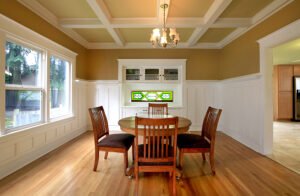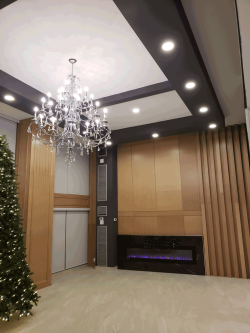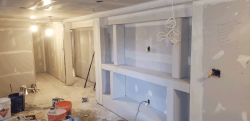
Reliable Service
No matter the size, shape and obstacles that occur on your premises, you will have reliable service.

Customer Satisfaction
Our company prides itself on reliable, safe, efficient and professional contractors. We will ensure complete communication during the removal process.
If you have any queries about a past or present removal, please contract us.

Certified Trades
The sites and services we encounter are always dealt with in a truly professional manner. We have the knowledge and expertise to make your vision come alive. Our experts are always reliable, safe and punctual.
Services
Clean & Modern
Brighter
The updated look of your ceilings enhances your living spaces by making them lighter and brighter, and visually larger.
Fresh
Stop dust accumulation and improve air quality while keeping your spaces cleaner and staying fresh. Future imperfections are easily manageable. With your modern look, you will also improve the resale value of your property.
More Light
We also offer pot light installation for your project.
Removal Process
First we cover all of your floors with kraft paper, then drape your walls and floors with plastic. Furniture, light fixtures, fans, and vents are wrapped and taped. This ensures all mess is contained and easy to clean as we go.
Once the work area is prepared, the popcorn ceiling is removed using state of the art ‘dustless’ equipment that sands as it vacuums for debris control during stucco removal.
Any flaws in the ceiling drywall following stucco sanding are made perfect with a thin skim coat of drywall compound.
Once the drywall compound is set, we sand your ceiling again to make it perfectly smooth, then prime and paint.
Request Quote Form



For Home and Business
We are available for your home and commercial properties.
Intricate Design
Architectural interest like waffle ceilings add incredible texture and interest. Waffle pattern is a traditional and modern way of making a space inviting with intersecting patterns. We are full of ideas for waffle ceiling designs, styles, shapes, and materials to help You decide on which coffer pattern will look best to your space.

Bulkhead ceilings resemble the bulkheads of a ship or submarine, intended to preserve buoyancy. In homes bulkhead ceilings are classy features that give the impression of a more private, intimate nook, a type of dropped ceiling, also called a false ceiling.
The design is typically lower than height of the room, often hanging from the true ceiling to visually separate spaces and give the impression of a different shape.

Tray ceiling (or ‘trey’ ceiling) is a reiteration of a bulkhead ceiling that is built to appear recessed rather than dropped down. This design can give the impression of a much larger room. Utilize options such as LED rope lights, pot lights to create a ceiling light box and other design elements such as dropped and recessed crown moulding for additional elegance. you will have an interesting aesthetic quality unique to your space.
Everything is installed at the same time as quickly and cleanly as possible, so you can enjoy your space thoroughly in a timely manner.

Ceiling Designs
Get the most enjoyment from your property with design features in critical spaces that have a high positive impact on your day to day use. Whether you desire a waffle ceiling or a flat high gloss ceiling, our Top Team Drywall understands your desires and can make it happen.
Lighter
You can choose how your space is lit up, the finished design can include pot lights, recessed lighting, back-lit panels and more (ceiling light box with LED rope lights?). We welcome any questions you may have to help you discover the best options for enviable results.
Designer
Your design ides are welcome, we offer the knowledge to make great selections for materials, styles and motifs to choose from. We take pride in serving our customers with finished spaces that create the mood they desired. Your classier new ceiling design is installed by our team of professionals expertly and efficiently.
Enjoy Now, Sell Later
These affordable quite simple to install design element can greatly raise the value of a space and are attractive options for formal dining areas and parlours. British remodeling trends from yesteryear such as coffer ceilings and bulkheads have had a recent resurgence, bringing back traditional styles.
Remodeling current ceiling structures with a new design is not complicated and our team can be finished in a relatively short span of time. Your home will have a look that feels like a fine hotel or historical architecture, and is far less expensive than either.
Request Quote Form

For Home and Business
We are available for your home and commercial properties.
Fine Finish
Seamless
When you hire our Top Team, we’ll show you a new version of “Straight and Smooth”. We use hepa air filtration systems to control dust when sanding to ensure the cleanliness of our job sites. We work clean and smart.
Smooth & Modern
We will always use the best suited plaster for every space, and we use reinforcement tape at all seams and corners. We will give you that highly desired uniformly smooth surface across seams, fasteners and drywall paper.
Top Level
We achieve a Level Five based on the description from the Gypsum Association. The steps include the drywall has been taped, first and second coated, and sanded lightly to remove tool marks before applying a thin skim coat to the entire surface including the seams and field. We may use a product that is a suitable substitute for the skim coat. The skim coat is sanded lightly and checked with a halogen light to look for any imperfections. The surface is ready to be coated with a high quality high drywall primer before painting.
Right for the Job
While finishing, we take into consideration areas of critical lighting from fixtures or windows. If you are using high gloss paint, a fine smooth finish is highly recommended. Ceilings are always a level 5 finish for the best outcome for your project.
Request Quote Form



For Home and Business
We are available for your home and commercial properties.
Smart & Bright
Quick Install
We can quickly install pot lights in your new ceiling to lighten up your life. Pot lights are a great wayto enhance a space and they are a timeless style.
Lighter and Lighter
Pot lights work great with other light sources such as table lamps and candles when you need that extra bit of character. We handle Pot Lights as well as LED Panels, LED Rope/Strip Lighting, and Recessed Lighting.
Dedicated to Savings
We work with you to make the best selections for your design and budget, including the selection of motion or timing switches. A brilliant way to light your home up.
Request Quote Form



For Home and Business
We are available for your home and commercial properties.
Fresh Look
For Home
Whether freshening up your home or painting new drywall, we make sure to prepare, repair and complete your home painting project so you are pleased with the budget and the workmanship.
We will provide a detailed quote that specifies the scope of work in detail for our painting services and the total cost of your job.
Our team ensures all your floors and furniture are covered, any hardware on doors and walls such as electrical outlet covers are removed, so your home remains clean from any drips.
For Business
We’ll be done in no time, so your business keeps running and you feel free to focus on your business instead of renovations. Our friendly and professional painters are available to transform your spaces. Are you painting offices or a fitness center? Are you a property management company painting condos and apartments? We take pride in quality workmanship completed in a timely manner, delivering the results you are looking for with minimal disruption for staff or residents.
We provide a detailed quote that specifies the scope of work in detail for our painting services and the total cost of your paint job.
Our team is experienced, insured and bondable, we assure you that the finished job will be excellent.
We welcome opportunities to partner with general contractors and design builders to deliver a job well done.
Timely Delivery
It is important to you that your property is completed professionally and on time. Are you a smaller custom home builder, or large volume production builder? Ensuring timely delivery of a completed project is just as important for your residents as it is for our home owner clients.
Our Process
After you’ve approved your quote, we will confirm the details:
• Confirm paint color and details such as dates and timelines.
• Ask you to remove all valuables, fragile items, pictures and shelves from the area being painted.
• Recommend finding a place for your pets before painting commences.
• Answer any questions you have about your painting project
Before starting to paint, our crew of professional painters will do a walkthrough to assess the project and get your home ready for painting:
• Cover your floors
• Move and cover your furniture
• Fill holes or cracks in the walls
• Repair drywall and finish, a perfect finish starts with smooth drywall.
• Cover and protect any hardware such as wall light fixtures or outlet covers in walls.
When painting is complete, we will clean up and leave you with that fresh new look!
Request Quote Form



For Home and Business
We are available for your home and commercial properties.
Use Space
Books, TV, Shelves
Make the most of your spaces with wall niches, best installed during renovations. Just ask, and we’ll help you with the best design to maximize the use of your space.
Lighter and Lighter
Pot lights work great with other light sources such as table lamps and candles when you need that extra bit of character. We handle Pot Lights as well as LED Panels, LED Rope/Strip Lighting, and Recessed Lighting.
Illuminated
Our knowledgeable Top Team Drywall ensures that all electrical work is completed safely. Considerations such as whether your ceiling has insulation in it are critical for placement, if recessed light housing is placed in contact with insulation may create a fire hazard. We place a high priority on safety.
Dedicated to Savings
We work with you to make the best selections for your design and budget, including the selection of motion or timing switches. A brilliant way to light your home up.
Request Quote Form

For Home and Business
We are available for your home and commercial properties.
Questions & Answers
Since the cost of removal generally is reflected by the size of the room, the age and quality of the popcorn ceiling, and if there are potentially hazardous materials that were used, such as asbestos, removal will be priced out per square foot of the ceiling.
A waffle ceiling is a versatile feature that can be used in your rooms to create drama and interest in otherwise sterile spaces.
Our Top Team Drywall can convert any ceiling into a waffle ceiling that is pleasing to the eye and is a pop of ‘Woah!’

Dining room with a coffered ceiling in a short and simple waffle pattern.
Coffered ceilings overall are excellent choices for large spaces where you want an extra element of style and luxury.
Cove molding creates a curved look in the corner where the ceiling meets the wall. While in a classic cove ceiling the curve is gentle and totally smooth from the wall to the ceiling using mesh and plaster, many contractors utilize trim and molding at the corner to create an illusion of a coved ceiling.
At times a whole or part of the molding may be painted in a contrasting colour to increase the drama in a space.
This ceiling finish can bring a formalized feel to a room, soften the lines of a room with many angles, or to add slight detail to a tray ceiling or other finished ceiling designs.
A tray ceiling, also called an inverted or recessed ceiling, features a center section that is several inches (or several feet) higher than the areas around the perimeter of the room
“Where there is more than one horizontal flat ceiling surface at different levels.”
A tray ceiling features a centre section that is several inches or feet higher than the areas around the perimeter of the room. This could also be called an inverted or recessed ceiling. This design feature can create a perceived sense of height in a space. A very modern look is simple and clean lines, while a more traditional feel may utilize crown molding to create a more layered look.
A very cool trend is utilizing LED rope to create lightboxes – This is a great option for entertainment rooms or sitting rooms where gentle soft lighting is desirable. Using light to create mood is a dynamic option for spaces that may otherwise be bland.
Coffered ceilings can take up volume in a room visually, and they can lower the ceilings making a room feel too small. A ceiling height of 9 feet is ideal, along with controlling the height of the beams to ensure you don’t infringe on the room.
Most modern coffered ceilings are not structural and are purely decorative. Alternatively, you must consider that your ceiling structure can handle the additional weight of a patterned ceiling.
Level 2 Typically in garages or unfinished basements, all the joints, angles and screw holes are mudded. Excess mud is troweled off wet.
Level 3 Generally you will find this common level of finishing in most homes. Joints, angles and screw holes are taped and mudded, with a second coat of mud, then sanded smooth and any ridges and imperfections are corrected. This is a wall ready for primer paint.
Level 4 All of the above, plus a third coat of mud is applied, sanded and smoothed, feathering the edges of layers of mud for an even smoother finished look.
Level 5 Achieving the highest Level 5 drywall finish, all the above is completed plus a fourth thin skim coat is applied to the entire surface of the drywall. This means the texture of the entire wall is uniform.
A level 5 finish is especially necessary for high gloss paint and lighting considerations to ensure the results are fabulous.